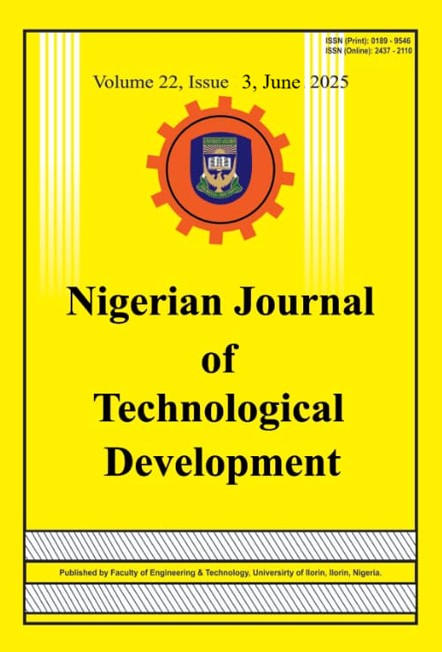Development of Green Composite Film for Food Paper Packaging Intercalated with Turmeric Oil
DOI:
https://doi.org/10.63746/njtd.v22i3.3281Keywords:
Green Composite, Thin-film, Kraft Paper, Food Packaging, Turmeric Oil, Antimicrobial MaterialsAbstract
The applications of petroleum-derived packaging materials, compared to edible coatings derived from biopolymer-based sources, lack inherent antimicrobial and barrier properties. In this study, a green-composite film for food packaging applications using turmeric oil intercalated to form biopolymer composite was developed. The bio-composite solution was prepared via the sol-gel process, utilizing a mixture of corn starch, carboxymethyl cellulose (CMC), chitosan, glycerin, and turmeric oil. The biopolymer composite was applied to unkrafted paper (UP) using roll-coating method and characterized for tensile strength (TS), surface morphology, thermal stability, surface wettability, and antimicrobial activity. The results were compared between UP and krafted paper coatings (KPCs). KPC revealed a decrease in the TS from 38.9 to 20.55 MPa and WCA also increased from 89.42 to 106o while water content and absorption increased from 7.42 to 29.32% and declined from 54.06 to 20.42%, respectively. The results also showed that both paper samples exhibited different levels of antimicrobial activity. The antimicrobial properties of the novel composite material were evaluated against Pseudomonas aeruginosa (PA), Staphylococcus aureus (SA), and Candida albicans (C.A) using disc diffusion method. The results showed that both coated paper samples demonstrated clear zones of inhibition for all tested microorganisms, confirming its antimicrobial efficacy. The developed green-composite film exhibited improved mechanical and antimicrobial properties, making it a promising material for food packaging applications.
References
Abdel Aziz, M.S. and Salama, H.E. (2021). Developing multifunctional edible coatings based on alginate for active food packaging. International Journal of Biological Macromolecules, 190, 837-844.
Alebooyeh, R., MohammadiNafchi, A. and Jokar, M. (2012). The effects of ZnO nanorodson the characteristics of sago starch biodegradable films.
Journal of Chemical Health Risks, 2(14) 13-16.
Arezoo, E., Mohammadreza, E., Maryam, M. and Abdorreza, M.N. (2020). The synergistic effects of cinnamon essential oil and nano TiO2 on antimicrobial and functional properties of sago starch films. International Journal of Biological Macromolecules, 157, 743-751.
Guillard, V., Sébastien, G., Claudio, F., Hélène, A-C., Patrice, B., Nathalie G. (2018). The next generation of sustainable food packaging to preserve our environment in a circular economy context. Frontiers in Nutrition, 5.
Van Hai, L., Zhai, L., Kim, H. C., Panicker, Pooja S. P., Duc Hoa Kim, J. (2020). Chitosan nanofiber and cellulose nanofiber blended composite applicable for active food packaging. Nanomaterials, 10(9), 1752.
Horst, C., Pagno, C.H., Flores, S.H. and Costa, T.M.H. (2020). Hybrid starch/silica films with improved mechanical properties. Journal of Sol-Gel Science and Technology, 95(1), 52-65.
Hou, X., Xue, Z., Xia, Y., Qin, Y., Zhang, G., Liu, H., Li, K. (2019). Effect of SiO2 nanoparticle on the physical and chemical properties of eco-friendly agar/sodium alginate nanocomposite film. International Journal of Biological Macromolecules, (125), 1289-1298.
Hussaini, A. Abdulrasheed, A., Raji, Y.O., Mohammed, J., Salis, A., Mohammed, A. (2024). Green polymer composite films for sustainable food packaging: A review. Nigerian Journal of Technological Development, 21(4), 70-84.
Liu, Y., Su, Y., Guan, J., Cao, J., Zhang, R., He, M., Gao, K., Zhou, L., Jiang, Z. (2018). 2D Heterostructure Membranes with Sunlight Driven Self Cleaning Ability for Highly Efficient Oil–Water Separation. Advanced Functional Materials, 28(13), 629–647.
Mustapha, N.FA. Jai, J., Noorsuhana, M.Y., Sharif, Z.I. (2018). Characterization of biocomposite film coating for food paper packaging. International Journal of Engineering & Technology, 7 (4,18), 325-330.
Norcino, L. B., Mendes, J. F., Natarelli, C. V.L., Manrich, A., Oliveira, J. E., Mattoso, L. H.C. (2020). Pectin films loaded with copaiba oil nanoemulsions for potential use as bio-based active packaging. Food Hydrocolloids, (106), 105862.
Perera, K.Y., Jaiswal, A.K. and Jaiswal, S. (2023). Biopolymer-based sustainable food packaging materials: Challenges, solutions, and applications. Foods, 12(12), 2422.
Pinto, L., Bonifacio, M. A., De Giglio, E., Santovito, E., Cometa, S., Bevilacqua, A., Baruzzi, F. (2021). Biopolymer hybrid materials: Development, characterization, and food packaging applications. Food Packaging and Shelf Life, (28), 100676.
Ruggero, F., Carretti, E., Gori, R., Lotti, T., Lubello, C. (2020). Monitoring of degradation of starch-based biopolymer film under different composting conditions, using TGA, FTIR and SEM analysis. Chemosphere, (246), 125770.
Shah, Y. A., Bhatia, S., Al-Harrasi, A., Oz, F., Khan, M. H., Roy, S., Esatbeyoglu, T., Pratap- Singh, A. (2024). Thermal properties of biopolymer films: Insights for sustainable food packaging applications. Food Engineering Reviews, 16(4), 497–512.
Xin, S., Xiao, L., Dong, X., Li, X., Wang, Y., Hu, X., Sameen, Dur E., Qin, W., Zhu, B. (2020). Preparation of chitosan/curcumin nanoparticles based zein and potato starch composite films for Schizothorax prenati fillet preservation. International Journal of Biological Macromolecules, (164), 211-221.

Downloads
Published
Issue
Section
License
Copyright (c) 2025 Nigerian Journal of Technological Development

This work is licensed under a Creative Commons Attribution-NonCommercial-ShareAlike 4.0 International License.
In accordance with the Copyright Act of 1976, which became effective January 1, 1978, the following statement signed by each author must accompany the manuscript submitted: "I, the undersigned author, transfer all copyright ownership of the manuscript referenced above to the Nigerian Journal of Technological Development, in the event the work is published. I warrant that the article is original, does not infringe upon any copyright or other proprietary right of any third party, is not under consideration by another journal, and has not been published previously. I have reviewed and approved the submitted version of the manuscript and agree to its publication in the Nigerian Journal of Technological Development." A copyright transfer form can be downloaded from the NJTD Website (http://njtd.com.ng/index.php/njtd). Author(s) will be consulted, whenever possible, regarding republication of material. All authors must have access to the data presented, and the authors and sponsor (if applicable) must agree to share original data with the editor if requested.





